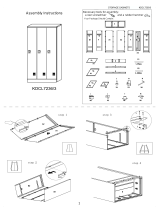Basic Information
1-2
Section 1 - Basic Information .............................. 1-1
Table of Contents .................................................... 1-2
Safe Servicing Practices ........................................ 1-3
Product Features .................................................... 1-4
Door Storage .......................................................... 1-5
Adjustable Door Bins .............................................. 1-5
Crisper Drawers ...................................................... 1-5
Adjustable Shelving ................................................ 1-5
Humidity Control...................................................... 1-5
Serial Plate.............................................................. 1-6
Care and Cleaning .................................................. 1-6
Cleaning The Inside .......................................... 1-6
Cleaning The Outside ........................................ 1-6
Section 2 - Electronic Control
.............................. 2-1
Electronic Temperature Control .............................. 2-2
Switching Between Refrigerator and
Freezer Mode ........................................................ 2-2
Setting Selection .................................................... 2-2
Operation of Electrical Control Components .......... 2-3
Freezer and Refrigerator Modules.......................... 2-3
DPDT Rocker Switch ............................................ 2-3
Ambient Thermostat................................................ 2-3
Fan Relay................................................................ 2-3
Service Diagnostic Mode ........................................ 2-4
Initiate Service Mode .............................................. 2-4
Defrost Cycle Timing .............................................. 2-4
Manual Defrost Mode ............................................ 2-4
Compressor Delay Start.......................................... 2-4
Voltage Range ........................................................ 2-4
Error Indication........................................................ 2-5
Fail Safe Mode........................................................ 2-5
Stuck Key ................................................................ 2-5
Exiting Fail Safe Mode............................................ 2-5
Section 3 - Refrigeration System
........................ 3-1
Definitions................................................................ 3-2
Safety Warnings...................................................... 3-2
Charging Sealed Systems ...................................... 3-2
Soldering ................................................................ 3-3
Basic Components.................................................. 3-3
Refrigerant Cycle .................................................... 3-3
Low/High Side Leak or Undercharge...................... 3-4
Testing for Refrigerant Leaks.................................. 3-4
Compressor Replacement ...................................... 3-4
To Flush the System................................................ 3-5
To Use Dry Nitrogen to Flush the System .............. 3-5
To Use Refrigerant to Flush the System ................ 3-5
Installing a New Compressor.................................. 3-6
Condenser Replacement ........................................ 3-7
Filter-Drier Installation ............................................ 3-8
Evaporator and Suction Line Replacement ............ 3-8
Equipment Needed for Evacuation & Recharging .. 3-9
Installing Evacuation and Recharging Equipment .. 3-9
Evacuating System..................................................3-10
Charging the System ..............................................3-10
Preparing the Charging Cylinder ............................3-10
Final Leak Test........................................................3-11
Verify Refrigerant Type in the System ....................3-12
Dedicated Equipment ............................................ 3-12
R-134a Refrigeration Systems .............................. 3-12
Miscibility of R-134a and Ester Oil ........................ 3-12
Water in the Refrigeration System ........................ 3-13
Vacuum Pump Maintenance.................................. 3-14
Refrigerant Leaks .................................................. 3-14
Leak Detection ...................................................... 3-15
R-134a Properties.................................................. 3-15
HFC-134a, CFC-12 Pressure Temp. Chart .......... 3-16
Inhalation Toxicity .................................................. 3-17
Cardiac Sensitization ............................................ 3-17
Spills or Leaks........................................................ 3-17
Skin and Eye Contact............................................ 3-17
Combustibility of HFC-134a .................................. 3-18
Leak Testing .......................................................... 3-18
Bulk Delivery and Storage .................................... 3-18
Filling and Charging Operations............................ 3-18
Refrigerant Recovery Systems.............................. 3-18
Thermal Decomposition ........................................ 3-18
Section 4 - Component T
eardown
Warnings and Cautions.......................................... 4-2
Exterior Components ............................................ 4-3
Door Handle...................................................... 4-3
Kickplate............................................................ 4-3
Door Hinge and Door Assembly ...................... 4-3
Door Stop.......................................................... 4-4
Door Gasket and Inner Panel .......................... 4-4
Gallon Door Bin ................................................ 4-5
Two Liter Door Bins .......................................... 4-5
Dairy Door ........................................................ 4-5
Door Switch ...................................................... 4-6
Interior Components .............................................. 4-6
Glass Shelf Assembly ...................................... 4-6
Crisper Drawer.................................................. 4-6
Crisper Cover Assembly .................................. 4-7
Light Shield ...................................................... 4-7
Light Fixture ...................................................... 4-7
Baffle Plate........................................................ 4-8
Evaporator Cover.............................................. 4-8
Control Switch .................................................. 4-8
Electronic Control.............................................. 4-9
Evaporator Fan Assembly ................................ 4-9
Defrost Thermostat .......................................... 4-10
Defrost Heater .................................................. 4-10
Evaporator ........................................................ 4-10
Compressor Area Components.............................. 4-11
Power Cord ...................................................... 4-11
Filter-Drier ........................................................ 4-11
Compressor ...................................................... 4-12
Drain Pan and Drain Pan Heater Loop ............ 4-13
Condenser Service............................................ 4-14




















